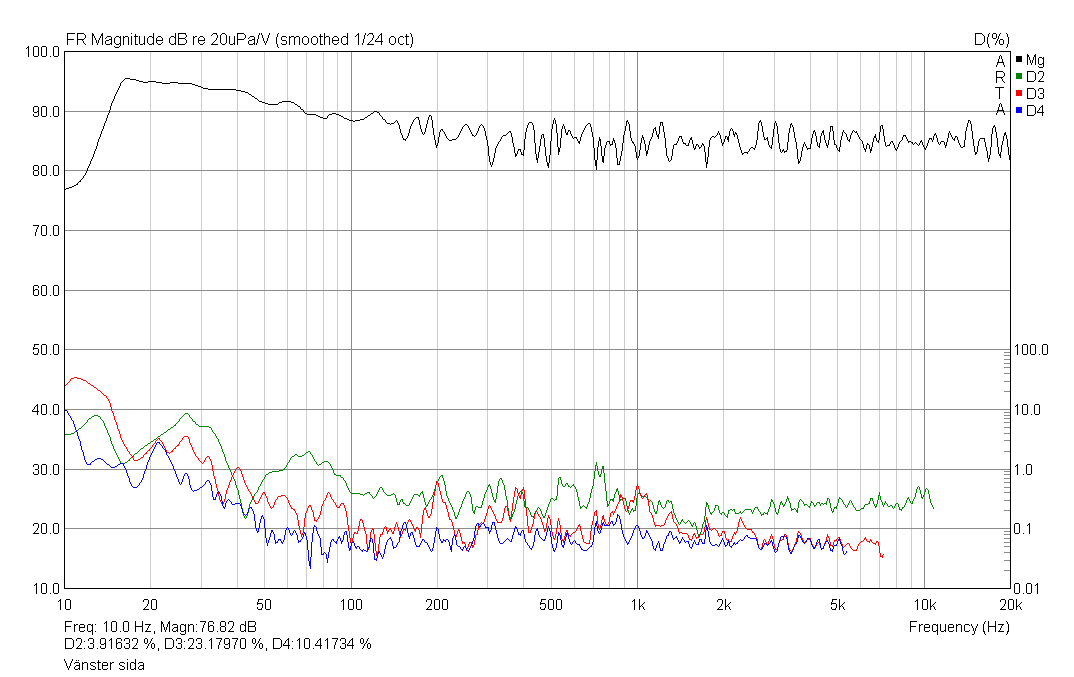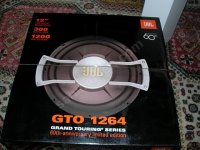I hope the specs of the JBL GTO1264 are similar. I could swap one oversized (poorly designed) horn (32 cu ft ext) for another slightly smaller horn if that is the case!
I can't find the T/S Parameters for them though.
Either that or a 6th order bandpass design I had in order to compact cabinet volume.
Also braced 12mm ply would be an advantage
I can't find the T/S Parameters for them though.
Either that or a 6th order bandpass design I had in order to compact cabinet volume.
Also braced 12mm ply would be an advantage
Attachments
Last edited:
A lot of things have happened since I built my two Kraken 212. The cinema is some else and the horns are part of a now professionally calibrated and customer room.
One thing I havent seen in this thread (and that hit us when calibrating my setup) is the quite high distorsion from the horn. My consultant blames the cheap drivers, and I guess that might be right.
Here is the measurement on dist if someone wants to see.
And BTW, here is the room they are integrated in
Look closely to the right of the left speaker at the bottom and you will see some panel missing, which is the opening of one of the horns.
One thing I havent seen in this thread (and that hit us when calibrating my setup) is the quite high distorsion from the horn. My consultant blames the cheap drivers, and I guess that might be right.
Here is the measurement on dist if someone wants to see.
An externally hosted image should be here but it was not working when we last tested it.
And BTW, here is the room they are integrated in
An externally hosted image should be here but it was not working when we last tested it.
Look closely to the right of the left speaker at the bottom and you will see some panel missing, which is the opening of one of the horns.
Hi barco,
Thanks for the measurement and the great room picture. If nothing else, that should be able to get quite loud w/ two Kraken 212.
Have you been able to measure w/ the respective HP and LP filters in place? Don't know if it will make much of a difference in the distortion plots, but when you look @ the impulse response (e.g.: in AkAbak) it makes all the difference.
Regards,
Thanks for the measurement and the great room picture. If nothing else, that should be able to get quite loud w/ two Kraken 212.
Have you been able to measure w/ the respective HP and LP filters in place? Don't know if it will make much of a difference in the distortion plots, but when you look @ the impulse response (e.g.: in AkAbak) it makes all the difference.
Regards,
The output is enough, lets put it that wayHi barco,
Thanks for the measurement and the great room picture. If nothing else, that should be able to get quite loud w/ two Kraken 212.
Have you been able to measure w/ the respective HP and LP filters in place? Don't know if it will make much of a difference in the distortion plots, but when you look @ the impulse response (e.g.: in AkAbak) it makes all the difference.
Regards,
In order for my setup to get the lowest possible distorsion the consultant put a LP filter on 55Hz for the horns. Currently we dont have any subsonic filter (might add compression there later on).
I am not sure what you want to see here, but here is the complete picture for my Left "system" (meaning horn + left front speaker).

Does that help?
That's crazy that there are no t/s parameters online for the jbl gto 1264!
It's allegedly a 'gussied up' GTO1202D, though of course only one way to know for sure: http://www.abtec.co.nz/infosheets/GTO_1202D1.jpg
GM
edit: then again, its published specs just popped up: http://www.elektroda.pl/rtvforum/topic1419276.html
Last edited:
It did yes! Thanks to my consultant, I wouldnt have known what to fix, how or what the output would be. I can tell you that now it sounds magical. The bass is excellent. Good thing I had some capacity in my "ordinary" front speakers to handle above 55Hz.Hi barco,
Yes, that looks great. Setting the LP for the TH @ 55 Hz sure helped that 55-80Hz distortion peak. Great system.
Regards,
Nice setup!
Thank you! I like it very much
I have 4 of the Infinity 1260w drivers, and I am wondering (as others have) if these could work well in this design. I have tried downloading Hornresp, but my computerskills are horrible and I cant even get it running... Even if I did I am pretty shure I would not understand much. I am more a builder than designer.  If anyone would be so kind as to help an old fart with this, it would be much appreciated.
If anyone would be so kind as to help an old fart with this, it would be much appreciated.
(and that hit us when calibrating my setup) is the quite high distorsion from the horn.
Depending on what amplifier you are using, you might be able to modify it to have a negative output impedance. It works wonders for lowering distortion from drivers pushed hard near and under its Fs.
My cheap 6,5 inch car audio coaxials could play 35 Hz with authority (all the way to xmax) without any noticeable distortion when driven from a negative output impedance amplifier. Without positive current feedback the distortion (mainly third order and higher) skyrocket below 70 Hz. Even at 10 Hz there was no noticeable higher order harmonics present at just below xmax.
Depending on what amplifier you are using, you might be able to modify it to have a negative output impedance. It works wonders for lowering distortion from drivers pushed hard near and under its Fs.
My cheap 6,5 inch car audio coaxials could play 35 Hz with authority (all the way to xmax) without any noticeable distortion when driven from a negative output impedance amplifier. Without positive current feedback the distortion (mainly third order and higher) skyrocket below 70 Hz. Even at 10 Hz there was no noticeable higher order harmonics present at just below xmax.
The Yamaha AST subwoofers used a similar scheme.
From what I recall, one review said that while the subwoofer could produce lower frequencies, the harmonics were only 6dB below the fundamental. That's a lot of HD. Knowing that our ears tend to be pretty bad at quantifying distortion in general and specifically at bass frequencies, I tend to be skeptical when anyone claims low distortion. Did you do any THD measurements (easy via REW) to confirm what you were hearing?
What car amp did you have that was stable at a negative ohm load?
I built my own simple two stage class A amp with a variable 0 ohm to - 4 ohm output impedance. I use my cheap 6,5 inch car coaxial drivers in a pair of offset driver quarterwave pipes in my home.
Knowing that our ears tend to be pretty bad at quantifying distortion in general and specifically at bass frequencies, I tend to be skeptical when anyone claims low distortion
If you play a 10 Hz sine wave through a cheap driver close to xmax and hear anything (except for some faint hissing from forced air-flow through the voice coil gap) you can be pretty sure it is distortion you are hearing.
I think it is very easy to hear distortion at low bass frequencies. Anything else except a low deep clean tone is distortion (or something mechanically rattling).
I find it very easy to differentiate between a 35 Hz tone or a 105 Hz third harmonic.
The distortion lowering effects of a negative output impedance has been known and used since the 50ies. It is very fun to play with. It makes a very large difference in SQ.
Did you do any THD measurements (easy via REW) to confirm what you were hearing?
The loud sonic "haze" of higher order harmonics is quite noticeable without REW. It is even more noticeable when it suddenly disappears when you switch on the negative output impedance.
Cheers,
Johannes
- Status
- This old topic is closed. If you want to reopen this topic, contact a moderator using the "Report Post" button.
- Home
- Loudspeakers
- Subwoofers
- Build your own 2x12" TH (The Kraken 212 TH)
